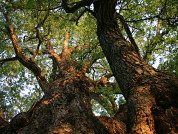Can we sustainably manage the native forest of North Patagonia?
DOI:
https://doi.org/10.25260/EA.19.29.1.0.775Abstract
The native forests of Northern Patagonia have a long history of human use, being one of the most studied ecosystems of Argentina. However, there are few examples of sustainably managed native forests. We propose that this is mainly due to the lack of political will from regional authorities, forest administration agencies, technicians and researchers in assisting forest owners to implement current legislation. Historically, forest owners have been ignored by an administrative system that has not considered their needs as well as by a scientific-technologic system that not used their empirical knowledge to develop realistic management packages. We consider that, even though the sustainable management of Patagonian native forests seems to be technically feasible, its implementation will depend on the will of the public sector to generate better conditions for an intersectoral collaboration that integrates different kinds of knowledge.
https://doi.org/10.25260/EA.19.29.1.0.775
Photo: Wikipedia
References
Attis Beltrán, H., L. Chauchard, and G. Martínez Pastur. 2015. Curvas preliminares de índice de sitio para bosques puros y mixtos de Nothofagus alpina y Nothofagus obliqua en la Patagonia argentina. Bosque 36(2):275-285.
Attis Beltran, H. 2016. Relaciones entre la estructura forestal y el rendimiento del bosque de Nothofagus alpina y Nothofagus obliqua en gradientes de edad y calidad de sitio”. Tesis doctoral, Universidad Nacional del Comahue, Río Negro, Argentina. Pp. 235.
Bava, J. 1999. Los bosques de lenga en la Argentina. Pp. 273-279 en C. Donoso and A. Lara (eds.). Silvicultura de los bosques nativos de Chile. Universidad Austral. Ed. Universitaria, Valdivia, Chile.
Bava, J., and J. P. López Bernal. 2006. Las cortas de selección en grupo en bosques de lenga de Tierra del Fuego. Quebracho 13:87-82.
Blackhall, M., E. Raffaele, J. Paritsis, F. Tiribelli, J. Morales, T. Kitzberger, J. H. Gowda, and T. T. Veblen. 2017. Effects of biological legacies and herbivory on fuels and flammability traits: A long‐term experimental study of alternative stable states. Journal of Ecology 105(5):1309-1322.
Chauchard, L., and R. Sbrancia. 2003. Modelos de crecimiento diamétrico para Nothofagus obliqua. Bosque 24(3):3-16
Chauchard, L., J. Bava, S. Castañeda, P. Laclau, G. Loguercio, P. Pantaenius, and V. Rusch. 2012. Manual para las buenas prácticas forestales en bosques nativos de norpatagonia. Unidad para el Cambio Rural, Ministerio de Agricultura, Ganadería y Pesca, Buenos Aires, Argentina.
Chauchard, L., M. C. Frugoni, and C. Novak. 2015. Manual de Buenas Prácticas para el Manejo de las Plantaciones Forestales en la Región de la Patagonia Andina. Unidad para el Cambio Rural, Ministerio de Agricultura, Ganadería y Pesca, Buenos Aires, Argentina.
Dezzotti, A., R. Sbrancia, D. Roat, M. Rodríguez-Arias, and A. Parisi. 2004. Colonización y crecimiento de renovales de Nothofagus después de cortas selectivas de un rodal en la Patagonia, Argentina. Investigación Agraria Serie Forestal 13(2):329-337.
Goldenberg, M., J. H. Gowda, C. Casas, and L. A. Garibaldi. 2018. Efecto de la tasa de descuento sobre la priorización de alternativas de manejo del matorral Norpatagónico argentino. Bosque 39(2):217-226.
Gowda, J. H. 2010a. La ilegalidad institucionalizada. Principal enemigo de nuestros bosques. Cap. I. Noti Forestal 217:5-7.
Gowda, J. H. 2010b. La ilegalidad institucionalizada, principal enemiga de nuestros bosques. Cap II. Noti Forestal 217:9-14.
Gowda, J. H., T. Kitzberger, and A. C. Premoli. 2012. Landscape responses to a century of land use along the northern Patagonian forest-steppe transition. Plant Ecology 213(2):259-272.
Gowda, J. H., T. Kitzberger, and L. Suárez. 2014. Comunidades vegetales y ecosistemas terrestres. Informe final. Parque nacional Nahuel Huapi, Bariloche, Río Negro, Argentina.
Kitzberger, T., G. L. Perry, J. Paritsis, J. H. Gowda, A. J. Tepley, A. Holz, and T. T. Veblen. 2016. Fire-vegetation feedbacks and alternative states: common mechanisms of temperate forest vulnerability to fire in southern South America and New Zealand. New Zealand Journal of Botany 54(2):247-272.
Kitzberger, T., and T. T. Veblen. 1999. Fire-induced changes in northern Patagonian landscapes. Landscape Ecology 14(1):1-15.
Mundo, I. A., T. Kitzberger, F. A. Roig Juñent, R. Villalba, and M. D. Barrera. 2013. Fire history in the Araucaria araucana forests of Argentina: Human and climate influences. International Journal of Wildland Fire 22(2):194-206.
Sola, G. 2016. Impacto del manejo silvícola sobre la estructura demográfica y genética de la regeneración natural en el bosque mixto de Nothofagus. Tesis doctoral. Universidad Nacional del Comahue, Bariloche, Río Negro, Argentina.
Sola, G., H. Attis Beltrán, L. Chauchard, and L. Gallo. 2015. Efecto del manejo silvicultural sobre la regeneración de un bosque de Nothofagus dombeyi, N. alpina y N. obliqua en la Reserva Nacional Lanín (Argentina). Bosque 36(1):113-120.
Raffaele, E., T. T. Veblen, M. Blackhall, and N. Tercero-Bucardo. 2011. Synergistic influences of introduced herbivores and fire on vegetation change in northern Patagonia, Argentina. Journal of Vegetation Science 22:59-71.
Rusch, V., and M. Sarasola. 1999. Empleo de Criterios e Indicadores en el manejo Forestal Sustentable. Biodiversidad. Parte I, Propuesta metodológica. Pp. 15-24 en Actas Segundas Jornadas Iberoamericanas sobre Diversidad Biológica, Tomo II. San Luis, Argentina.
Tercero-Bucardo, N., T. Kitzberger, T. T. Veblen, and E. Raffaele. 2007. Afield experiment on climatic and herbivore impacts on post-fire tree regeneration in north-western Patagonia. Journal of Ecology 95:771-779.
Urretavizcaya, M. F. 2006. Ciprés de la cordillera, Plantación de bosques quemados y recomendaciones para su establecimiento. Patagonia Forestal 12(4):13-16.
Willis, B. 1914. El Norte de la Patagonia, naturaleza y riquezas. Scribner Press. New York, USA.

Downloads
Published
How to Cite
Issue
Section
License
Copyright (c) 2019 Javier Grosfeld, Luis Chauchard, Juan H. Gowda

This work is licensed under a Creative Commons Attribution 3.0 Unported License.
Authors retain their rights as follows: 1) by granting the journal the right to its first publication, and 2) by registering the published article with a Creative Commons Attribution License (CC-BY 4.0), which allows authors and third parties to view and use it as long as they clearly mention its origin (citation or reference, including authorship and first publication in this journal). Authors can make other non-exclusive distribution agreements as long as they clearly indicate their origin and are encouraged to widely share and disseminate the published version of their work.


